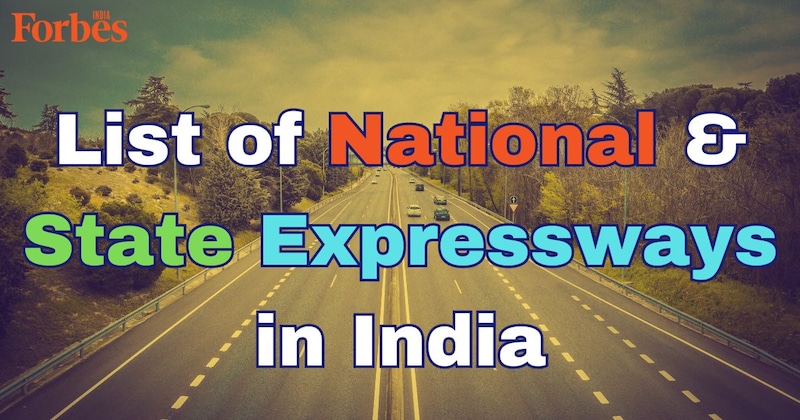
Expressways are high-speed, divided highways with limited entry and exit points designed for traffic moving between cities or through urban areas. They are separated from local traffic and have distinct features–such as gentle curves, six or eight lanes, access ramps, and lane markings to help reduce congestion. There are three types of expressways in India: National Expressways, State Expressways, and Bypass Expressways.
Expressways in India
Expressways, the top-tier roads in India, measured 5,579 km in length as of July 2023, while an additional 8,366 km were under construction. The expressway network expanded by 3,577 km, growing from 2,002 km to 5,579 km over the past four years.Also Read: Top 10 busiest airports in India
Key highlights of Indian expressways:
- The longest expressway in India is the partially opened Delhi-Mumbai Expressway, with a length of 692km.
- The Delhi—Dasna (UP border) section of the Delhi–Meerut Expressway is the widest expressway, with 14 lanes.
- Uttar Pradesh has the most operational expressways, stretching to 1,500 km and eight expressways as of 2023.
- Delhi has the smallest expressway network, at just 26.6 km, followed by West Bengal, at 30.17 km, and Bihar, at 33 km.
National Expressways
As of April 2021, the Ministry of Road Transport and Highways has designated eight expressways as National Expressways (NE). The table below includes only the operational expressways.
| Designation | Expressway | Total Length |
|---|---|---|
| NE 1 | Ahmedabad–Vadodara Expressway | 93 km |
| NE 2 | Eastern Peripheral Expressway (KGP) | 135 km |
| NE 3 | Delhi–Meerut Expressway | 96 km |
| NE 4 | Delhi–Mumbai Expressway | 659 km |
Also Read: The how and why of highway hypnosis
State Expressways
State Expressways are funded by the State or central government and aim to connect various regions within the state. While they are not categorised as National Expressways, they may be managed by state or national authorities.
| Expressway | States | Length |
|---|---|---|
| #1 Amritsar–Jamnagar Expressway | Punjab, Haryana, Rajasthan, Gujarat | 500 km |
| #2 Delhi-Panipat Expressway | Delhi, Haryana | 70.5 km |
| #3 Mumbai Nagpur Expressway | Maharashtra | 625 km |
| #4 Trans–Haryana Expressway | Haryana | 227 km |
| #5 Bundelkhand Expressway | Uttar Pradesh | 296 km |
| #6 Purvanchal Expressway | Uttar Pradesh | 340 km |
| #7 Delhi–Meerut Expressway | Delhi, Uttar Pradesh | 96 km |
| #8 Raipur–Bhilai–Durg Expressway | Chhattisgarh | 27 km |
| #9 Raipur–Naya Raipur Expressway | Chhattisgarh | 12 km |
| #10 Raipur–Bilaspur Expressway | Chhattisgarh | 127 km |
| #11 Western Peripheral Expressway | Haryana | 135.6 km |
| #12 Eastern Peripheral Expressway | Uttar Pradesh, Haryana | 135 km |
| #13 Agra–Lucknow Expressway | Uttar Pradesh | 302.2 km |
| #14 Yamuna Expressway | Uttar Pradesh | 165.5 km |
| #15 Delhi–Faridabad Skyway | Delhi, Haryana | 4.4 km |
| #16 Delhi–Gurgaon Expressway | Delhi, Haryana | 27.7 km |
| #17 Jaipur–Kishangarh Expressway | Rajasthan | 90 km |
| #18 Ahmedabad–Vadodara Expressway | Gujarat | 93.1 km |
| #19 Mumbai–Pune Expressway | Maharashtra | 94.5 km |
| #20 Delhi–Noida Direct Flyway | Delhi, Uttar Pradesh | 9.2 km |
| #21 Noida–Greater Noida Expressway | Uttar Pradesh | 24.5 km |
Bharatmala Pariyojana: Impact on expressways and future prospects
The Bharatmala Pariyojana is a crucial highway development initiative that addresses critical infrastructure needs by constructing economic corridors, inter-corridors, and feeder routes, enhancing national corridor efficiency, improving coastal and port connectivity, and Greenfield Expressways.Greenfield Expressways are designed to bypass populated areas, opting instead for new routes to promote development in untouched regions. This approach helps reduce land acquisition costs and construction timelines.Also Read: 42 UNESCO World Heritage sites in India
Greenfield Expressways in India are designed to be initially constructed as 8-lane wide expressways, with plans to expand to 12 lanes. The maximum speed limit is set at 120 km/h for all types of vehicles. The program aims to develop 17 proposed greenfield expressways, each initially featuring eight lanes. These expressways are intended to improve traffic and freight management, particularly in areas with high freight traffic volumes.
Sagaramala Project: Impact on expressways and future prospects
The Sagarmala Project in India aims to enhance the country’s logistics sector overall. The project focuses on connectivity between ports and domestic production and consumption centres through rail, road, pipeline, and multi-modal logistics hubs. By optimising infrastructure investment, the project aims to reduce logistics costs for domestic and EXIM cargo. This includes enhancing road connectivity to ports and other transportation modes.Also Read: Budget 2024: Not a lot for auto and aviation, but highways will grow, especially in Bihar
While the direct impact on expressways is not explicitly mentioned, the project’s focus on improving overall connectivity and reducing logistics costs will likely have positive implications for expressways in India.
FAQs
1. How is the expressway different from the Highway?
Expressways are distinguished from highways by their controlled access, higher speed limits, limited intersections, and focus on rapid long-distance travel.2. Which is India’s first expressway?
India’s first expressway is the Mumbai-Pune Expressway, a high-speed, controlled-access road designed for rapid and efficient travel between Mumbai and Pune.
